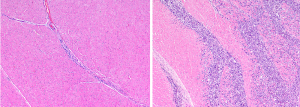Most of the time symptoms of non-Hodgkin’s disease (also known as “non-Hodgkin’s lymphoma”) present more subtly in the beginning.
It may be that there is a pain-free lymph gland swelling that may be the first sign of the disease. It may manifest itself by enlarged tonsils, which do not respond to antibiotic therapy. With lymph glands growing in the mediastinum there might be pressure symptoms from neighboring organs such as the lungs, the heart or the esophagus.
Similarly with lymph glands being affected in the gastrointestinal tract symptoms may simulate a malabsorption syndrome or a gastric tumor. When symptoms of weight loss, fever and night sweats develop, the NHL is usually already spread throughout the body. Two unusual symptoms are typical for NHL, but absent in Hodgkin’s lymphoma: 1) congestion and swelling of the face and neck. This is a sign of obstruction of one of the major veins (superior vena cava). 2) compression of the ureter can occur between the kidneys and the bladder from enlarging lymph glands leading to renal failure.

Symptoms Of Non-Hodgkin’s Disease (Heart Failure From Invading Lymphoma Cells Right; Normal Heart Tissue Left)
Replacement of red blood cell precursors and platelet precursors in the bone marrow from leukemia cell invasion can lead to secondary anemia and bleeding problems. Finally, the lack of B cell lymphocytes from the bone marrow leads to a lack of antibody producing cells and thus to hypogammaglobulinemia. This means that serious life threatening bacterial infections can overcome the patient. Septicemia is a common cause of death.
References:
1. N Engl J Med 329(14):987-994,1997.
2. The Merck Manual of Diagnosis and Therapy. 17th edition, editors M.Beers and R.Berkow. Whitehouse Station, N.J., 1999.
3. Cancer: Principles & Practice of Oncology. 4th edition, edited by V.T. DeVita et al., Lippincott Co., Philadelphia, 1993. Chapters 51 and 52.
4. Cancer: Principles&Practice of Oncology. 5th edition, volume 2. Edited by Vincent T. DeVita, Jr. et al. Lippincott-Raven Publ., Philadelphia,PA, 1997. Chapter 44,Lymphomas.
5. HY Dong et al. Mod Pathol 2001 May;14(5):472-481.
6. NL Kobrinsky et al. J Clin Oncol 2001 May 1;19(9):2390-2396.
7. Conn’s Current Therapy 2004, 56th ed., Copyright © 2004 Elsevier
8. Ferri: Ferri’s Clinical Advisor: Instant Diagnosis and Treatment, 2004 ed., Copyright © 2004 Mosby, Inc






